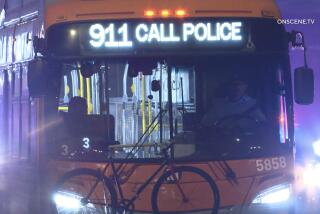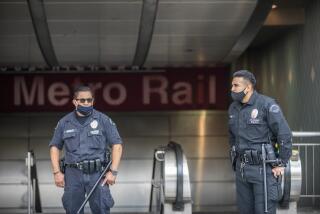Orange Line Model Beset by Crashes
When San Fernando Valley residents and others expressed worries about the potential for accidents on the Orange Line, transit officials repeatedly assured them the busway would be safe -- and pointed to a similar transit system in Miami as evidence.
But the Miami busway had in fact been plagued with accidents when it first opened -- some similar to those the Orange Line has experienced since opening last week, according to records and interviews.
It was only after the Miami system reduced its bus speeds and made other safety improvements that accidents declined. Now, the Los Angeles County Metropolitan Transportation Authority has adopted one similar measure: slowing down Orange Line buses as they go through intersections.
On Thursday, Orange Line buses crawled through the route’s 36 crossings at 10 mph -- a new MTA policy instituted after two accidents Wednesday resulted in 15 injuries. Before, the buses were allowed to travel 25 to 30 mph through crossings.
The Miami busway is an eight-mile route built on a former railway that parallels a highway and intersects streets. Between its February 1997 opening and November 2000, 67 crashes occurred on busway intersections, resulting in dozens of injuries and two deaths, according to a National Bus Rapid Transit Institute report.
The crashes so concerned Florida officials that they required the buses to slow down, first from a top speed of 45 mph through crossings to 15 mph, and finally to stopping outright at major intersections.
They also turned off the corridor’s signal priority system, which meant the buses had to wait for red lights just like regular cross-traffic.
Since those measures were adopted, accidents along the Miami busway have dropped significantly, said Manuel Palmeiro, a spokesman for Miami-Dade Transit, which runs the service.
Still, a 2002 MTA environmental impact report for the Orange Line touted the Miami busway as “an example of safety performance.” The report also said the Orange Line would actually be a better system, with “additional safety measures ... that are not present in the Miami project.”
During the review process for the Orange Line, some concerned residents cited the accidents on the Miami busway. The MTA responded in a 2004 report, saying it had “taken every precaution to design the Orange Line in as safe a manner as members of the traffic engineering and civil engineering professions know how to do.”
The report said the Orange Line would include dedicated turning lanes, signage and other safety features -- but was silent on one of the key changes Miami made on its system: reducing the buses’ speed.
It was only recently that the MTA considered doing so.
After an MTA delegation visited the Miami busway a few months ago, the rank-and-file employees overseeing bus driver training began requiring drivers to not cruise through intersections at normal posted speed limits, about 35 mph, but to “cover their brakes” with their foot as their buses enter a crossing, slowing the buses to about 25 to 30 mph.
Jose Ubaldo, a spokesman for the MTA, declined Thursday to talk about the reports and their references to the Miami busway, saying the agency was focused on the Orange Line.
Some transportation experts said the Miami experience should have given the MTA a clear idea of what to expect when the Orange Line opened.
Joel Volinski, director of the National Center for Transit Research at the University of South Florida, said he and two researchers flew to Los Angeles a few months ago to examine the Orange Line while it was still under construction over a former rail right-of-way.
He said they were astounded by the similarities between the two busways, including unusual rail-like crossings, with a few streets intersecting at odd angles, sometimes requiring motorists to make extra-wide turns onto nearby cross streets.
“It’s pretty predictable what’s happening in L.A.,” Volinski said.
Added James E. Moore II, director of the Transportation Engineering Program at USC, “It was largely foreseeable, and the agency was warned.”
Minutes after Wednesday’s second and more serious accident, which sent more than a dozen passengers to hospitals with minor injuries, Richard Hunt, the MTA’s general manager overseeing Valley operations, ordered Orange Line buses to slow to 10 mph at crossings.
Officials said that because Orange Line buses are running more slowly, an end-to-end trip on the 14-mile route now takes about two minutes longer. Previously, a one-way trip on the east-west route, from Warner Center in Woodland Hills to North Hollywood, took just under 40 minutes.
Also Thursday, city and transit officials gathered for a news conference at City Hall to announce that they’re working on safety issues and to call the busway -- which had 11,000 riders Wednesday -- a success.
“Yes, there have been a few problems,” said Los Angeles Mayor Antonio Villaraigosa, who heads the MTA. But he blamed the accidents on the motorists involved, who authorities say had run red lights. “We’re doing all the things we need to do to be safer.”
Earlier in the day, Villaraigosa dispatched traffic officers with the L.A. Department of Transportation to key intersections along the busway.
“It’s for high visibility,” said traffic Officer Gina Tellechea, who worked the intersection at Corbin Avenue and Topham Street, where one of Wednesday’s collisions occurred.
But some said that not all Orange Line drivers were slowing down as required.
“They’re supposed to slow down, but some of them don’t,” said Officer Alex Foster, who directed traffic at Topham and Corbin. “We’re supposed to turn them in.”
Many MTA drivers say they have had “near misses” on the busway -- slamming on the brakes or honking to avoid motorists who have run red lights. Some motorists complain that the busway’s intersections, which resemble rail crossings, are confusing.
Other MTA drivers say not much can be done to protect against traffic scofflaws.
“Any day there could be an accident on any line,” said James Green, an MTA driver for 3 1/2 years. “All [motorists] have to do is pay attention to the signs and signals.” He added that even with crossing gates, flashing lights and other safety additions, if motorists are “on the phone, they aren’t going to see the flashing lights. They’re not going to be paying attention.”
More to Read
Sign up for Essential California
The most important California stories and recommendations in your inbox every morning.
You may occasionally receive promotional content from the Los Angeles Times.









